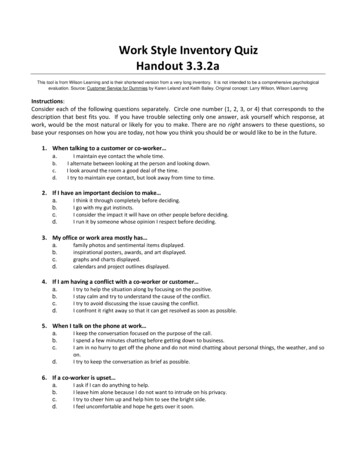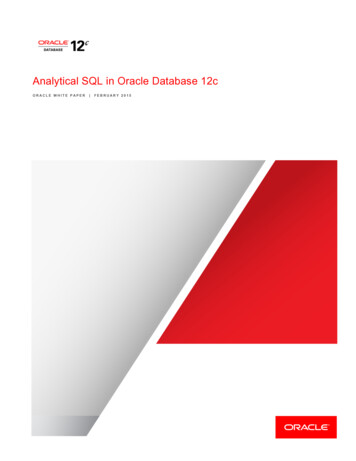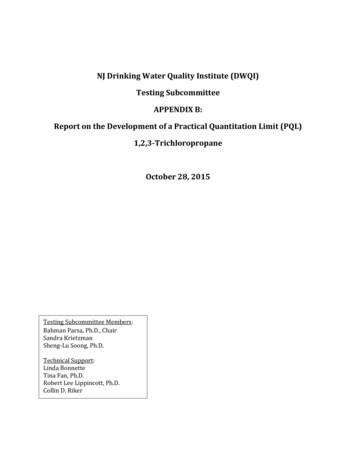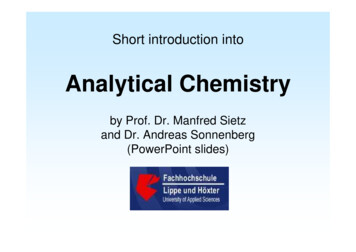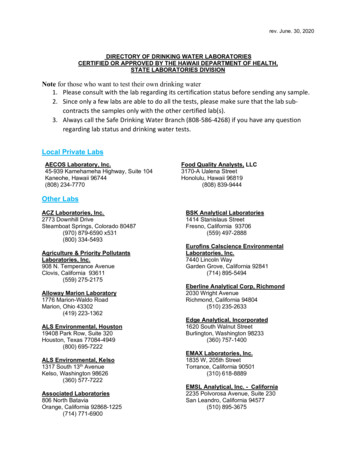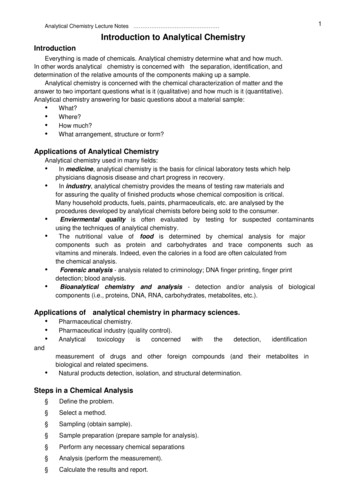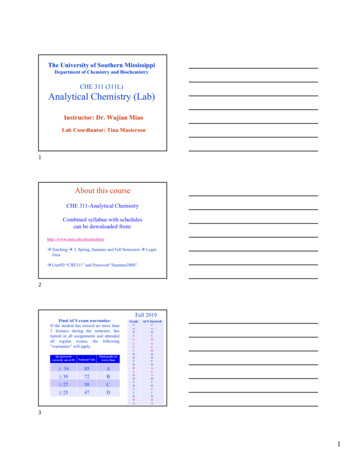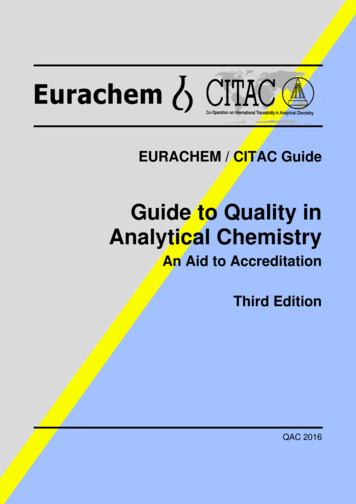
Transcription
EURACHEM / CITAC GuideGuide to Quality inAnalytical ChemistryAn Aid to AccreditationThird EditionQAC 2016
Eurachem/CITAC GuideGuide to Quality in Analytical ChemistryAn Aid to AccreditationThird editionAcknowledgementsThis document has been prepared by members of the Eurachem Education and Training Working Group andothers co-opted for this task. Those who have contributed to this edition are listed below. The authors aregrateful to those other individuals and organisations who have contributed comments, advice and assistance.The revision of this Guide was in part supported by the UK government Department for Business, Energy &Industrial Strategy (BEIS).EditorVicki BarwickLGC (UK)Task GroupFatma AkçadağTUBITAK Ulusal Metroloji Enstitusu (UME) (TR)Mine BilselTUBITAK Ulusal Metroloji Enstitusu (UME) (TR)Renata BorroniDepartment of Public Veterinary Health and Food Safety, Istituto Superiore di Sanitá (IT)Pedro Pablo Morillas Bravo Canal de Isabel II Gestión (ES)Ales FajgeljInternational Atomic Energy Agency (CITAC member)Martina HedrichFederal Institute for Materials Research and Testing (BAM) (DE)Nineta HrasteljEuCheMSPerihan Yolcı ÖmeroğluUludag University (TR)Mariana Arce OsunaCentro Nacional de Metrología (CENAM) (MX) (CITAC member)Marina PatriarcaDepartment of Public Veterinary Health and Food Safety, Istituto Superiore di Sanitá (IT)Elizabeth PrichardConsultant (UK)Riin RebaneUniversity of Tartu (EE)Lorens SibbesenLAB Quality (DK)Kevser TopalTUBITAK Ulusal Metroloji Enstitusu (UME) (TR)Kyriacos TsimillisPancyprian Union of Chemists (CY)Isabelle VercruysseBelab (BE)Alex WilliamsConsultant (UK)Recommended citationThis publication should be cited* as: “V. Barwick (Ed), Eurachem/CITAC Guide: Guide to Quality inAnalytical Chemistry: An Aid to Accreditation (3rd ed. 2016). ISBN 978-0-948926-32-7. Available fromwww.eurachem.org.”*Subject to journal requirements
Guide to Quality in Analytical Chemistry: An Aid to AccreditationEnglish editionThird edition 2016ISBN 978-0-948926-32-7Copyright 2016Copyright in this document is held by the contributing authors. Allenquiries regarding reproduction in any medium, includingtranslation, should be directed to the Eurachem secretariat.
Quality in Analytical ChemistryEurachem/CITAC GuideContentsForeword1Abbreviations and symbols21Notes for the reader42Introduction53Definitions and terminology74Accreditation105Scope of accreditation126The analytical task137Specification of analytical requirement148Analytical strategy159Non-routine analysis1610Personnel1711Sampling, sample handling and s and consumables2715Metrological traceability2816Measurement uncertainty3017Methods/procedures for calibrations and tests3218Method validation3319Calibration3620Reference materials3821Quality control and proficiency testing4022Computers and computer controlled systems4223Laboratory audit and review45Appendix A – Quality audit: Areas of particular importance to a chemistry laboratory46Appendix B – Instrument calibration and performance checks51Bibliography55QAC 2016Page i
Quality in Analytical ChemistryEurachem/CITAC GuideForewordThis edition is a revision of the CITAC/Eurachem Guide published in 2002. The 2002 edition was developedfrom CITAC Guide 1 (which in turn was based on the Eurachem/WELAC Guide).This revision reflects changes that were introduced with the publication of the 2005 version ofISO/IEC 17025. The terminology has also been updated to take account of ISO/IEC 17000:2004,ISO 9000:2015 and the 3rd edition of the International Vocabulary of Metrology – Basic and generalconcepts and associated terms (JCGM 200:2012 – VIM).The Guide focuses on the requirements of ISO/IEC 17025, however the content should also be of use toorganisations seeking accreditation or certification against the requirements of standards such as ISO 15189or ISO 9001, or compliance with the Principles of Good Laboratory Practice. Similarly, although the Guidehas the title ‘Guide to Quality in Analytical Chemistry’ it is anticipated that it will also be of benefit todisciplines other than chemistry. For those working in microbiology, it should be noted that Eurachem haspublished a Guide specifically for microbiological laboratories.†The Guide will also provide useful information both for laboratories that wish to establish a qualitymanagement system but are not seeking formal recognition, and for those involved in education and training.The 2002 edition of the Guide contained an extensive reference and bibliography section. For ease ofmanagement, the bibliography section in this edition contains only literature cited in the text. Additionaldocuments related to accreditation and quality assurance can be found in a ‘reading list’ under the menu item‘Publications’ on the Eurachem website at www.eurachem.org.†M. Eleftheriadou and K. C. Tsimillis (eds.), Eurachem Guide: Accreditation for microbiologicallaboratories (2nd ed. 2013), ISBN 978-91-87017-92-6. Available from www.eurachem.org.QAC 2016Page 1
Quality in Analytical ChemistryEurachem/CITAC GuideAbbreviations and symbolsThe following abbreviations, acronyms and symbols appear in this Guide.AMCAnalytical Methods Committee of the RSCAOAC Internationala globally recognised standards developing organisationBIPMInternational Bureau of Weights and MeasuresCITACCooperation on International Traceability in Analytical ChemistryCLSIClinical and Laboratory Standards InstituteCRMcertified reference materialEAEuropean cooperation for AccreditationECEuropean CommissionEQAexternal quality assessmentEUEuropean UnionGLPGood Laboratory PracticeGMPGood Manufacturing PracticeGUMEvaluation of measurement data – Guide to the expression of uncertainty inmeasurementHPLChigh performance liquid chromatographyIECInternational Electrotechnical CommissionILACInternational Laboratory Accreditation CooperationISOInternational Organization for StandardizationIUPACInternational Union of Pure and Applied ChemistryJCGMJoint Committee for Guides in Metrologykcoverage factor (used in the calculation of expanded uncertainty)LIMSlaboratory information management systemLODlimit of detectionLOQlimit of quantificationMLAMultilateral AgreementMRAMutual Recognition ArrangementOECDOrganisation for Economic Cooperation and DevelopmentOIMLInternational Organization on Legal MetrologyPCRpolymerase chain reactionPVCpoly vinyl chlorideQAquality assuranceQCquality controlQMSquality management systemRSCRoyal Society of Chemistry (UK)PTproficiency testingQAC 2016Page 2
Quality in Analytical ChemistryEurachem/CITAC GuideRMreference materialsstandard deviationSIinternational system of unitsSOPstandard operating procedureustandard measurement uncertaintyUexpanded measurement uncertaintyUVultravioletVCMvinyl chloride monomerVIMInternational vocabulary of metrology – Basic and general concepts and associatedtermsWHOWorld Health OrganizationQAC 2016Page 3
Quality in Analytical ChemistryEurachem/CITAC Guide1 Notes for the reader1.1 Aims and objectives1.2 Terminology1.1.1 The aim of this Guide is to providelaboratories with guidance on best practice for theanalytical operations they carry out. The guidancecovers both qualitative and quantitative analysiscarried out on a routine or non-routine basis. Aseparate Guide covers research and developmentwork [1].1.2.1 In the revision of this Guide one of the mainareas of focus has been the updating of terminologyto reflect developments since the previous edition,published in 2002. The Guide follows, wherepossible,theterminologydefinedinISO/IEC 17000 [8], ISO 9000 [9] and the 3rd editionof the VIM [10]. This has been supplemented,where necessary, with terminology used inISO/IEC 17025 [2].1.1.2 The guidance is intended to help thoseimplementing a quality management system (QMS)in a laboratory, in particular those seekingaccreditation against the requirements ofISO/IEC 17025 [2]. For those working towardsaccreditation it will help explain the meaning of thestandard. The guidance will also be useful toorganisations seeking accreditation or certificationagainst the requirements of standards such asISO 15189 [3], ISO 15195 [4] or ISO 9001 [5], orcompliance with the Principles of Good LaboratoryPractice (GLP) [6] or Good Manufacturing Practice(GMP) [7], and to those involved in the irements. The Guide should also be of value tothose involved in education and training.1.1.3 This Guide concentrates on the technicalaspects of the quality management of a laboratory,with particular emphasis on those areas whereinterpretation is required for chemical testing orrelated measurements. The aspects of qualitymanagement not covered in detail by this Guide (forexample contract review, records, reports andcomplaints) are fully addressed in other documents,such as ISO/IEC 17025 [2].QAC 2016However, in some cases, it may be difficult todecide which term to use when several similar termsare in use. For clarity, it is considered important touse a term consistently throughout the Guide. Oneexample is the term used to describe the documentthat gives a detailed description of the method usedin a laboratory. For quantitative analysis VIM refersto the measurement procedure, in ISO/IEC 17025this is referred to as the method, in ISO 15189 [3] itis the examination procedure and many laboratoriesrefer to their standard operating procedure (SOP). Inline with other recent Eurachem guides the TaskGroup has decided to adhere to ISO/IEC 17025 anduse the generic term ‘method’. The term‘concentration’ is used on its own (i.e. unqualified)when a generality is required. In the Guide this termshould be taken to represent a family of terms whichincludes mass fraction, mass concentration, amountof substance concentration, etc.The terms in VIM related to analytical chemistry arefurther explained in the Eurachem Guide‘Terminology in analytical measurement’ [11].Page 4
Quality in Analytical ChemistryEurachem/CITAC Guide2 Introduction2.1Every analytical measurement must producea result that is sufficiently accurate to allow the userto make appropriate decisions; it must be fit-forpurpose. Every laboratory, no matter the field ofanalysis, is aware of the need for quality assuranceof its results. Over the last decades agreement hasbeen reached as to what is required to achievequality. The starting point is to use a method thathas been validated. The values for the keyperformance parameters (e.g. precision, bias)obtained during method validation provide a sourceof values to input into the measurement uncertaintyevaluation of the results obtained using thevalidated method. This is still insufficientknowledge to enable the producer of the result toclaim that this result can legitimately be comparedto a result obtained in another laboratory or at adifferent time. To enable this assertion to be madeone needs metrological traceability. ical traceability are pivotal for achieving areliable result and that is the reason they appear inISO/IEC 17025 [2]. However they are essential inall laboratories (large and small) irrespective ofaccreditation requirements. To help laboratoriesthere are guides available on the Eurachem inty and metrological traceability [12-14].This Guide indicates where method aceability fit into quality assurance.2.2Appropriate quality management aims toenable a laboratory to show that it has adequatefacilities and equipment for carrying out specificanalyses and that the work was carried out bycompetent personnel in a controlled manner,following a documented validated method. Qualitymanagement should focus on the key issues whichdetermine the quality, cost and timeliness of results,and avoid diversion of energies into less importantissues.2.3Good quality management, including itsformal recognition by accreditation, certificationetc., helps to ensure that results are fit-for-purpose.However, it is important for both laboratories andtheir customers to realise that quality managementcannot guarantee that 100% of the individual resultswill be reliable. There are two reasons for this:i) Human errors can occur, where, for example, theresults for two samples are mixed-up. In a well-QAC 2016run laboratory, the frequency of human errorswill be small, but not zero [15].ii) Random and systematic measurement errors alsooccur, leading to uncertainty in a measurementresult. The probability of a result lying within thestated uncertainty range depends on the level ofconfidence employed, but again, even in a wellordered laboratory, deviant results willoccasionally occur and very occasionally thedeviation will be large.The role of quality management is to put in placemeasures aimed at minimising the frequency ofquality failures, and to identify and correct thembefore results are reported to the customer. As theeffort taken increases, the number of quality failuresis expected to reduce. It is necessary to balance thecost of quality management against the benefit inreducing quality failures to an acceptable (non-zero)level.2.4The principles of quality management havebeen formalised in a number of published guidelinesand standards. Those most widely recognised andused in analytical laboratories are:2.4.1 ISO/IEC 17025 [2]. This standard isrelevanttolaboratoriesdevelopingamanagement system for administrative, qualityand technical operations. It addresses thetechnical competence of laboratories to carry outspecific tests and calibrations and is used byaccreditation bodies worldwide as the corerequirements for the recognition of alaboratory’s competence.2.4.2 ISO 9001 [5]. This standard relatesprimarily to quality management for facilitiescarrying out production, or providing services.2.4.3 ISO 15189 [3]. This standard wasprepared specifically to cover medicallaboratories carrying out the testing orexamination of materials derived from thehuman body. The standard is based onISO 9001 [5] and ISO/IEC 17025 [2] butspecifies requirements that are particular tomedical laboratories.2.4.4 OECD Principles of Good LaboratoryPractice (GLP) [6] and its national and sectoralequivalents. These guidelines are concerned withthe organisational processes and conditionsunder which laboratory studies related to certainregulatory work are carried out.Page 5
Quality in Analytical Chemistry2.5CurrentstandardssuchasISO/IEC 17025 [2],ISO 9001 [5]andISO 15189 [3] place emphasis on continualimprovement. An organisation should continuallyimprove the effectiveness of its QMS throughactivities such as setting quality objectives,reviewing audit results, and management reviews.ISO 9001 promotes the adoption of a processapproach when developing, implementing andimproving the effectiveness of a QMS. Thisapproach is also referred to as ‘Plan-Do-CheckAct’: Plan – establish the objectives and processesnecessary to deliver results in accordance ��s policies; Do – implement the processes; Check – monitor and measure processes andproducts against policies, objectives andrequirements for the product and report theresults; Act – take actions to continually improveprocess performance.QAC 2016Eurachem/CITAC Guide2.6The laboratory will select a standardaccording to its needs. However, central to thisGuide is the contention that, at the technical level,good practice in quality management is independentof the formal QMS adopted.2.7A laboratory may decide to design its ownquality management procedures or it may followone of the established standards or guidelines. In thelatter case it may claim informal compliance againstthe standard or protocol, or ideally may undergoindependent assessment from an official expertbody, with the aim of gaining independentendorsement of its QMS. Such independentassessment/endorsement is variously known asaccreditation, certification or compliance dependingon which standard or other document theassessment is made against. In particular areas oftesting, accreditation is sometimes mandatoryhowever, in most cases, the laboratory is free todecide what quality management measures it wishesto adopt. The independent assessment route hasrecognised advantages, particularly where thelaboratory’s customers require objective evidence ofthe technical competence of the laboratory. Forclarification of the term ‘accreditation’ as used inthis Guide, see Sections 3.4 and 4.Page 6
Quality in Analytical ChemistryEurachem/CITAC Guide3 Definitions and terminologyThere are a number of important terms used inquality management and conformity assessmentwhose meaning may vary according to the contextin which they are used. It is important to understandthe distinction between the various terms. The keyreference is ISO/IEC 17000 [8]. Other terms can befound in ISO 9000 [9] and the VIM [10]. Aselection of terms likely to be encountered in thelaboratory are presented here.in that technical competence is not specificallyaddressed.3.6QUALITY ASSURANCE (QA): Part ofquality management focused on providingconfidence that quality requirements will befulfilled (ISO 9000 [9])The main requirements in a laboratory are: A QMS;3.1QUALITY: Degree to which a set ofinherent characteristics fulfils requirements(ISO 9000 [9]) A suitable laboratory environment;3.2MANAGEMENT SYSTEM: System toestablish policy and objectives and to achieve thoseobjectives (ISO 9000 [9]) Training procedures and records;3.3QUALITY MANAGEMENT SYSTEM:Management system to direct and control anorganisation with regard to quality (ISO 9000 [9])3.3.1 In practice, the terms ‘managementsystem’ and ‘quality management system’ areoftenusedinterchangeably.InISO/IEC 17025 [2] ‘management system’ isused, however in ISO 15189 [3] ‘qualitymanagement system’ is the preferred term.3.4ACCREDITATION: Third-party attestationrelated to a conformity assessment body conveyingformal demonstration of its competence to carry outspecificconformityassessmenttasks(ISO/IEC 17000 [8])3.4.1 In the context of a laboratory makingmeasurements, accreditation is a formalrecognition that a laboratory is competent tocarry out specific calibrations or tests. Themechanism under which accreditation is grantedis described in Section 4 and the corerequirementsaredocumentedinISO/IEC 17025 [2].3.4.2 Accreditation is also used in the contextof ISO 9000 [9] based activities to describe theprocess whereby an accreditation body formallyconfirms a certification body as competent tocertify organisations as being compliant with theISO 9000 series of standards.3.5CERTIFICATION: Third-party attestationrelated to products, processes, systems or persons(ISO/IEC 17000 [8])3.5.1 Certification, (sometimes known asregistration) primarily differs from accreditationQAC 2016 Educated, trained and skilled personnel; Specifications for reagents, calibrants andmeasurement standards (including referencematerials (RMs)); Equipment suitably maintained and calibrated; Procedures for sampling (where the laboratory isresponsible for this activity); Procedures for sample handling; Documented and validated methods; Metrological traceability of results; Evaluation of measurement uncertainty; Internal quality control procedures; Participation in proficiency testing (PT)/externalquality assessment (EQA); Procedures for checking and reporting results; Procedures for implementing preventive andcorrective actions; Internal audit and review procedures.3.7QUALITY CONTROL (QC): Part ofquality management focused on fulfilling qualityrequirements (ISO 9000 [9])QC procedures relate to ensuring the quality ofresults obtained for specific samples or sets ofsamples and include: Analysis of QC samples; Analysis of measurement standards (includingRMs); Analysis of blind samples; Analysis of sample blanks and reagent blanks[12]; Analysis of spiked samples;Page 7
Quality in Analytical Chemistry Analysis in duplicate; Use of QC charts to monitor trends; Assessment of correlation of results obtained fordifferent characteristics of a sample, providedthat a known relationship exists.More details on QC are given in Section 21.3.8AUDIT:Systematic,independent,documented process for obtaining records,statements of fact or other relevant information andassessing them objectively to determine the extentto which specified requirements are fulfilled(ISO/IEC 17000 [8])3.8.1 In practice, quality audits take threeforms. An audit carried out within the laboratoryby its own personnel is often referred to as an‘internal audit’ or ‘first-party’ audit. ‘Externalaudits’ include ‘second-party audits’, conductedby an organisation having an interest in thelaboratory (such as a customer), and ‘third-partyaudits’ which are undertaken by an independentexternal body, such as an accreditation body. Athird-party audit carried out by an accreditationbody, as part of the accreditation process, isknown as an assessment.In this Guide the term audit refers to an internalaudit; assessment refers to a third-party externalaudit.3.9REVIEW: Verification of the suitability,adequacy and effectiveness of selection anddetermination activities, and the results of theseactivities, with regard to fulfilment of specifiedrequirements by an object of conformity assessment(ISO/IEC 17000 [8])3.9.1 A review checks all aspects of the QMSto ensure that it is still effective and achieves theset objectives. The review is carried out bysenior management with responsibility for boththe quality policy and the work of the laboratory.The review will include the results from internalaudits.More details on audit and review are given inSection 23.3.10 MEASURAND: Quantity intended to bemeasured (VIM [10])3.10.1 The specification of the measurandshould be sufficiently detailed to avoid anyambiguity. It is important to remember thatmeasurand is not an alternative for analyte [11].3.11 STANDARD: This word has a number ofdifferent meanings in the English language. In theQAC 2016Eurachem/CITAC Guidepast it has been used routinely to refer both towritten standards, i.e. widely adopted procedures,specifications, technical recommendations, etc., andto chemical or physical standards used forcalibration purposes. In this Guide, to minimiseconfusion, standard is used only in the sense ofwritten standards. The term measurement standardis used to describe chemical or physical standards,used for calibration or validation purposes, such as:chemicals of established purity and theircorresponding solutions of known concentration;UV filters; weights, etc. Certified referencematerials (CRMs) are one (important) category ofmeasurement standards.3.12 REFERENCEMATERIAL(RM):Material, sufficiently homogeneous and stable withreference to specified properties, which has beenestablished to be fit for its intended use inmeasurement or in examination of nominalproperties (VIM [10])3.13 CERTIFIED REFERENCE MATERIAL(CRM): Reference material, accompanied bydocumentation issued by an authoritative body andproviding one or more specified property valueswith associated uncertainties and traceabilities,using valid procedures (VIM [10])3.14 MEASUREMENTPROCEDURE:Detailed description of a measurement according toone or more measurement principles and to a givenmeasurement method, based on a measurementmodel and including any calculation to obtain ameasurement result (VIM [10])Note that in ISO/IEC 17025 [2] and this Guide theterm ‘method’ is used (see Section 1.2.1).3.15 METROLOGICALTRACEABILITY:Property of a measurement result whereby the resultcan be related to a reference through a documentedunbroken chain of calibrations, each contributing tothe measurement uncertainty (VIM [10])3.16 MEASUREMENT UNCERTAINTY: Nonnegative parameter characterising the dispersion ofthe quantity values being attributed to a measurand,based on the information used (VIM [10])3.17 METHOD VALIDATION: Confirmationby examination and the provision of objectiveevidence that the particular requirements for aspecificintendedusearefulfilled(ISO/IEC 17025 [2])Note that the VIM [10] provides a different, but inprinciple similar, definition of validation. Furtherdiscussion of the terminology relating to methodPage 8
Quality in Analytical ChemistryEurachem/CITAC Guidevalidation can be found in the Eurachem guides onterminology [11] and method validation [12].QAC 2016Page 9
Quality in Analytical ChemistryEurachem/CITAC Guide4 Accreditation4.1The references to accreditation in this andsuccessive sections refer to ISO/IEC 17025 [2]. Itsrequirements form the basis for accreditationgranted by an accreditation body and agreementsare in place to support the equivalence ofassessments (see Section 4.9). In the EU specificlegislation applies for the establishment of nationalaccreditationbodies(Regulation(EC)No 765/2008 [16]).4.2The standard ISO/IEC 17025 [2] containstwo sets of requirements, one relating tomanagement of the laboratory and the other dealingwith technical issues.4.2.1 Requirementsrelatingtothemanagement of a laboratory are very much inline with the requirements given inISO 9001 [5]), i.e. ensuring that policy,procedures and appropriate documentation are inplace for: Organisationresponsibilities;anddelegationof Establishment, assessment and improvementof the QMS; Control of documents and records; Ensuring customers areconsistently(contracts,feedback);dealt withcooperation, Safeguarding the quality of supplies, servicesand any subcontracted work; Identifyinganddealingwithanynonconformities in relation to the establishedQMS; Confirming the management’s currentawareness of the effectiveness andappropriateness of the QMS.These are the requirements found in Section 4of the standard.NOTE: This Guide does not deal specificallywith any of these management issues – exceptfor the requirements on internal audits andmanagement reviews (see Section 23).4.2.2 Requirements relating to the technicalcompetence of the laboratory to carry outspecific types of tests or calibrations are given inSection 5 of the standard. These are the subjectof the more detailed recommendations found inthe following sections of this Guide.QAC 20164.3The requirements of the leading qualitystandards/protocols have many common or similarelements.Forexample,ISO/IEC 17025 [2]incorporates the ISO 9001 [5] management systemelements which are applicable to laboratories. Forlaboratories within organisations who are seekingcertification according to ISO 9001 (and thereforenot looking to obtain a third-party evaluation oftheir technical competence as in the case of anaccreditation), ISO/IEC 17025 and this Guide canstill be recommended as useful tools for securinggood quality work in that laboratory.4.3.1 Laboratories who comply with therequirements of ISO/IEC 17025 [2] will operatea QMS that meets the principles of ISO 9001 [5].They will not therefore require separatecertification to the requirements of ISO 9001 forthose activities covered by the ISO/IEC 17025accreditation. However, the organisation maychoose to obtain certification for non-technicalactivities which are not covered by theaccreditation, such as finance, human resourcesor sales and marketing.4.4Accreditation is granted to a laboratory for aspecified set of activities (i.e. tests or calibrations)following assessment of that laboratory by anaccreditation body. Such assessments will typicallyinvolve an examination of the methods in use, thefacilities/environment, equipment and personnelinvolved, and the means of controlling theprocedures being performed. Furthermore, the QMSand the related documentation of the laboratory willbe examined.4.5The methods will be examined to ensurethey are technically appropriate for the intendedpurpose, that they have been validated anddocumented clearly and unambiguously, and thattheir performance is under control (e.g. through theuse of QC charts). The performance of tests may bewitnessed to ensure documented procedures arebeing followed and interpreted in a consistent way.The laboratory’s performance in PT schemes orother interlaboratory comparisons will also be afocal point. Assessment may additionally include a‘performance audit’ or ‘measurement audit’, wherethe laboratory is required to analyse specificsamples and achieve acceptable levels of accuracy.4.6It is the responsibility of the laboratory toensure that all procedures used are appropriate fortheir intended purpose. The assessment processPage 10
Quality in Analytical Chemistryexamines whether the procedures are fit-forpurpose.4.7Each accreditation body has establishedprocedures against which it operates, assesseslaboratories and grants accreditation. To ensureharmonised assessments, the accreditation bodiesthemselves must work in accordance with therequirements of ISO/IEC 17011 [17].4.8Assessors are chosen against specifiedcriteria. The selection criteria for assessorsappointed by accreditation bodies are specified inISO/IEC 17011 [17]. These include the requirementfor technical expertise in the specific areas ofoperation being assessed.QAC 2016Eurachem/CITAC Guide4.9The benefit of accreditation is that it enablespotential customers to have confidence in thequality of the work performed by the laboratory.Since the introduction of formal requirements forthe competence of laboratories, the endorsementconferred by accreditation and other assessmentshas gained worldwide recognition and plays animportant role in trade. Many laboratoryaccreditation bodies (who have been evaluated andfound to satisfy relevant requirements, see Section4.7) have signed a Multilateral Agreement (MLA)with European Accreditation (EA) members, and/ora Mutual Recognition Arrangement (MRA) ation (ILAC).Page 11
Quality in Analytical ChemistryEurachem/CITAC Guide5 Scope of nt to all or part of
Quality in Analytical Chemistry Eurachem/CITAC Guide QAC 2016 Page 4 1 Notes for the reader 1.1 Aims and objectives 1.1.1 The aim of this Guide is to provide laboratories with guidance on best practice for the analytical operations they carry out. The g
